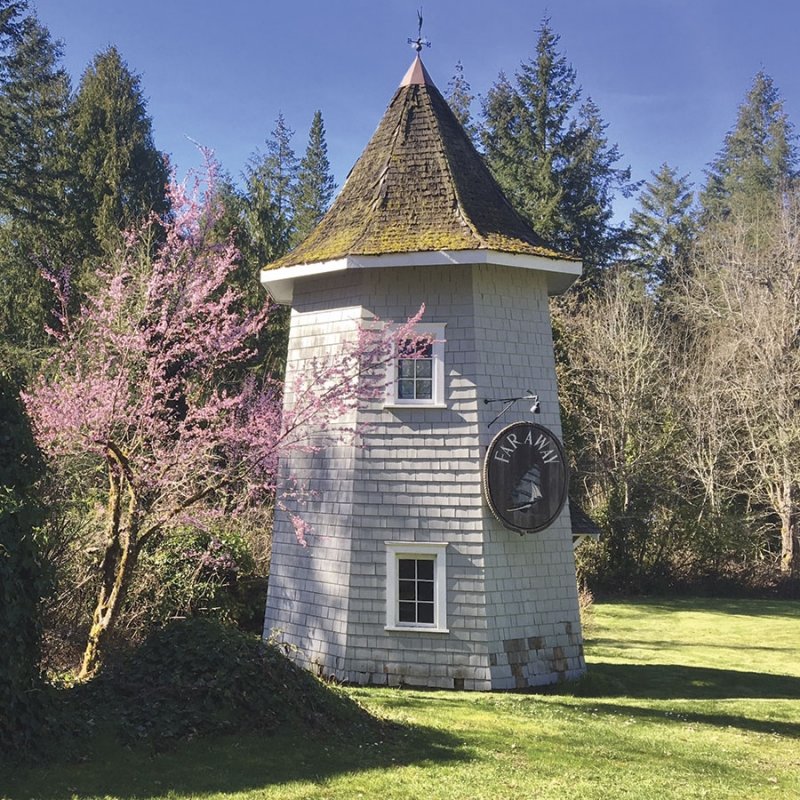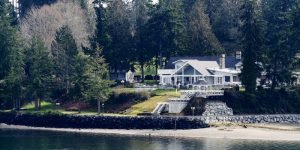 The Sipple Well House was built to resemble a lighthouse. Brook Hurst Stephens
The Sipple Well House was built to resemble a lighthouse. Brook Hurst Stephens
Taking on the restoration of historic sites requires a special sort of person and Brook Hurst Stephens is one of them.
In August, 2016, Brook and her husband, Kim, purchased the Faraway Estate on Filucy Bay in Longbranch.
Faraway is one of the most expansive and intact historic properties left on the Key Peninsula. The main house was built in 1915 for Frank McDermott, head of the Bon Marche department store (now Macy’s). The Stephens have an ambitious plan to restore the property but want to respect McDermott’s original design.
A news article from the May 9, 1915, Tacoma Daily Ledger, reproduced in “Echoes of Faraway” by Longbranch resident Connie Hildahl, described McDermott’s search for a place to build his dream vacation home: “(He) has been cruising all over Puget Sound for several years looking for the prettiest spot … in his choice of Longbranch, McDermott believes he has found the most ideal.”
 New Owners Work to Bring Back Faraway
New Owners Work to Bring Back Faraway
The once ideal property has suffered from neglect for the last decade. The outbuildings were used for storage of everything from building materials to trash, routine maintenance was ignored, and the grounds became overgrown with blackberries.
Undaunted, the Stephens have begun the task of bringing the property up to code while remaining sensitive to the intrinsic value of the historic estate.
In addition to the main house, there is a small barn and stable, a chicken house, a green house, a four-bedroom guesthouse, a caretaker’s house, and at least two other buildings. What was once referred to as the chauffeur’s garage is still almost completely hidden by overgrowth.
Brook Stephens has a clipboard of to do lists for every room.
Because of the historical significance of several of the structures, the work is more complicated than a simple remodel. Before they could assess the condition of the outbuildings and begin to compile a catalogue of projects, they had to empty them. “It has taken months just to remove everything from the buildings,” she said. “The greenhouse was filled with glass windows and doors and blackberries had grown through the windows.” Other buildings were filled with junk and little else.
“The greenhouse is usable” now that it is empty and has new shelving and potting tables, Stephens said. “I may be able to have things growing by summer.”
One unique find was a small stove uncovered by her father. It had enough identifying marks on it that the maker was traced to a foundry in France that operated until the mid-1800s.
Local arborist Tim Kezele has been removing undergrowth and trimming trees to improve the views from the main house and let more sunlight reach the garden areas. He is very knowledgeable about the property, having worked with three different owners over the past 40 years. None of them paid much attention to developing the landscape and gardens, he said, and he is excited to see the new owners “really going for it.”
Stephens has spent hours and days pruning the climbing roses along the 200-foot pergola that links the house to the parking area, and estimates that she still has forty more to trim. Her long-range plan is to join the KP farming community as a cut-flower farmer. She is also well known as a master food preserver and looks forward to sharing her knowledge with the community. (See her new food and lifestyle column in this edition.)
For more information and to follow the Stephens’ progress, go to Historic Faraway on Facebook at
https://www.facebook.com/HistoricFaraway.
 New Owners Work to Bring Back Faraway
The once ideal property has suffered from neglect for the last decade. The outbuildings were used for storage of everything from building materials to trash, routine maintenance was ignored, and the grounds became overgrown with blackberries.
Undaunted, the Stephens have begun the task of bringing the property up to code while remaining sensitive to the intrinsic value of the historic estate.
In addition to the main house, there is a small barn and stable, a chicken house, a green house, a four-bedroom guesthouse, a caretaker’s house, and at least two other buildings. What was once referred to as the chauffeur’s garage is still almost completely hidden by overgrowth.
Brook Stephens has a clipboard of to do lists for every room.
Because of the historical significance of several of the structures, the work is more complicated than a simple remodel. Before they could assess the condition of the outbuildings and begin to compile a catalogue of projects, they had to empty them. “It has taken months just to remove everything from the buildings,” she said. “The greenhouse was filled with glass windows and doors and blackberries had grown through the windows.” Other buildings were filled with junk and little else.
“The greenhouse is usable” now that it is empty and has new shelving and potting tables, Stephens said. “I may be able to have things growing by summer.”
One unique find was a small stove uncovered by her father. It had enough identifying marks on it that the maker was traced to a foundry in France that operated until the mid-1800s.
Local arborist Tim Kezele has been removing undergrowth and trimming trees to improve the views from the main house and let more sunlight reach the garden areas. He is very knowledgeable about the property, having worked with three different owners over the past 40 years. None of them paid much attention to developing the landscape and gardens, he said, and he is excited to see the new owners “really going for it.”
Stephens has spent hours and days pruning the climbing roses along the 200-foot pergola that links the house to the parking area, and estimates that she still has forty more to trim. Her long-range plan is to join the KP farming community as a cut-flower farmer. She is also well known as a master food preserver and looks forward to sharing her knowledge with the community. (See her new food and lifestyle column in this edition.)
For more information and to follow the Stephens’ progress, go to Historic Faraway on Facebook at https://www.facebook.com/HistoricFaraway.
New Owners Work to Bring Back Faraway
The once ideal property has suffered from neglect for the last decade. The outbuildings were used for storage of everything from building materials to trash, routine maintenance was ignored, and the grounds became overgrown with blackberries.
Undaunted, the Stephens have begun the task of bringing the property up to code while remaining sensitive to the intrinsic value of the historic estate.
In addition to the main house, there is a small barn and stable, a chicken house, a green house, a four-bedroom guesthouse, a caretaker’s house, and at least two other buildings. What was once referred to as the chauffeur’s garage is still almost completely hidden by overgrowth.
Brook Stephens has a clipboard of to do lists for every room.
Because of the historical significance of several of the structures, the work is more complicated than a simple remodel. Before they could assess the condition of the outbuildings and begin to compile a catalogue of projects, they had to empty them. “It has taken months just to remove everything from the buildings,” she said. “The greenhouse was filled with glass windows and doors and blackberries had grown through the windows.” Other buildings were filled with junk and little else.
“The greenhouse is usable” now that it is empty and has new shelving and potting tables, Stephens said. “I may be able to have things growing by summer.”
One unique find was a small stove uncovered by her father. It had enough identifying marks on it that the maker was traced to a foundry in France that operated until the mid-1800s.
Local arborist Tim Kezele has been removing undergrowth and trimming trees to improve the views from the main house and let more sunlight reach the garden areas. He is very knowledgeable about the property, having worked with three different owners over the past 40 years. None of them paid much attention to developing the landscape and gardens, he said, and he is excited to see the new owners “really going for it.”
Stephens has spent hours and days pruning the climbing roses along the 200-foot pergola that links the house to the parking area, and estimates that she still has forty more to trim. Her long-range plan is to join the KP farming community as a cut-flower farmer. She is also well known as a master food preserver and looks forward to sharing her knowledge with the community. (See her new food and lifestyle column in this edition.)
For more information and to follow the Stephens’ progress, go to Historic Faraway on Facebook at https://www.facebook.com/HistoricFaraway.








